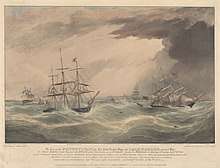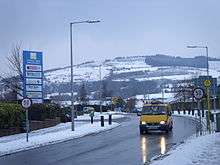Night of the Big Wind
The Night of the Big Wind (Irish: Oíche na Gaoithe Móire) was a powerful European windstorm that swept across Ireland and the United Kingdom beginning on the afternoon of 6 January 1839, causing severe damage to property and several hundred deaths; 20% to 25% of houses in north Dublin were damaged or destroyed, and 42 ships were wrecked.[1] The storm attained a very low barometric pressure of 918 hectopascals (27.1 inHg) and tracked eastwards to the north of Ireland, with gusts of over 100 knots (185 km/h; 115 mph), before moving across the north of England to continental Europe, where it eventually dissipated. At the time, it was the worst storm to hit Ireland for 300 years.[2][3] Liverpool also suffered severely, with many shipwrecks and structural damage resulting from strong winds. 120 people died as a result of such accidents in the city alone. Two major shipwrecks resulted in damage worth at least £500,000, equivalent to £52.2 million in 2020.[4]
Meteorological situation
The storm developed after a period of unusual weather. Heavy snow, rare in Ireland, fell across the country on the night of 5 January, which was replaced on the morning of 6 January by an Atlantic warm front, which brought a period of complete calm with dense, motionless, cloud cover. Through the day, temperatures rose well above their seasonal average, resulting in rapid melting of the snow.
Later on 6 January, a deep Atlantic depression began to move towards Ireland, forming a cold front when it collided with the warm air over land, bringing strong winds and heavy rain. First reports of stormy weather came from western County Mayo around noon, and the storm moved very slowly across the island through the day, gathering strength as it moved.
By midnight the winds reached hurricane force. Contemporary accounts of damage indicate that the Night of the Big Wind was the most severe storm to affect Ireland for many centuries. It is estimated that between 250 and 300 people lost their lives in the storm. Severe property damage was caused, particularly in Connacht, but also in Ulster and northern Leinster. Between a fifth and a quarter of all houses in Dublin suffered damage ranging from broken windows to complete destruction.[2] Much of the inland damage was caused by a storm surge that drew large quantities of sea water inland, resulting in widespread flooding.
Damage

Even well-built buildings suffered structural damage, including new factories and military barracks. The newly constructed St. Mary's Roman Catholic Church in Derrytrasna was completely destroyed; one of the steeples of the Church of Ireland church in Castlebar was blown down, and a number of large country houses were unroofed. Among the poorly built homes of the poor, damage was more severe and many were completely destroyed. A total of 42 ships, most along the less sheltered west coast, were wrecked while unsuccessfully trying to ride out the storm: a majority of the recorded casualties occurred at sea.[1]
Stacks of hay and corn were widely destroyed, resulting in severe starvation among livestock in the following months.
Legacy
The Night of the Big Wind became part of Irish folk tradition. Irish folklore held that Judgment Day would occur on the Feast of the Epiphany, 6 January. Such a severe storm led many to believe that the end of the world was at hand.
The Old-Age Pensions Act 1908 introduced pensions for over-70s, but many Irish Catholics prior to the Registration of Births and Deaths (Ireland) Act, 1863 had no birth registration.[5] One of the questions used to establish proof of age was whether the applicant remembered the Night of the Big Wind.
A popular story holds that the storm inspired the Director of Armagh Observatory, the Reverend Romney Robinson, to develop the cup-anemometer, which remains the commonly used wind measuring device today.
Related writing
Irish language poems about the event include "Oíche na Gaoithe Móire" by Micheál de Búrc (c.1800 – 1881) and "Oíche Nollaig na mBan" by Seán Ó Ríordáin (1916–77). The latter's title means "Eve of Women's Christmas"; Women's Christmas is observed in Ireland on the feast of the Epiphany (6 January). The first verse describes a storm on that date (5 January) while the second recounts the poet's desire that his eventual death should coincide with a similar storm.
The novel The Big Wind by Beatrice Coogan uses the events of January 1839 as a historical backdrop.
See also
References
- Forsythe, W.; C. Breen; C. Callaghan; R. McConkey (2000). "Historic storms and shipwrecks in Ireland: a preliminary survey of severe synoptic conditions as a causal factor in underwater archaeology" (PDF). International Journal of Nautical Archaeology. 29 (2): 247–259. doi:10.1111/j.1095-9270.2000.tb01455.x. Archived from the original (PDF) on 9 March 2007. Retrieved 10 July 2017.
- Sweeney, J. (1000). "A three-century storm climatology for Dublin 1715–2000" (PDF). Irish Geography. 33 (1): 1–14. doi:10.1080/00750770009478595.
- Shields, Lisa; Fitzgerald, Denis (1989). "The 'Night of the Big Wind' in Ireland, 6–7 January 1839" (PDF). Irish Geography. 22 (1): 31–43. doi:10.1080/00750778909478784.
- "A Chronological Listing of Early Weather Events" (PDF). Retrieved 6 June 2020.
- "HISTORY OF REGISTRATION IN IRELAND" (PDF). Ireland: Department of Social Protection. Retrieved 6 January 2016.
Further reading
- Carr, Peter (1993). The Night of the Big Wind. Belfast: White Row Press. ISBN 1-870132-50-5.
External links
- Topic: Winds records from the Irish Folklore Commission, in Irish and English, many relating to the Night of the Big Wind
- "Oiche na Gaoithe Moire...the night of the big wind" by Bridget Haggerty Irish Culture and Customs

